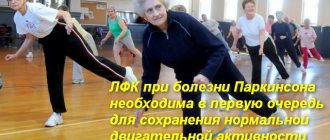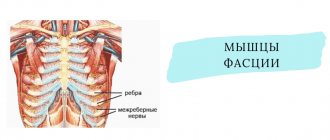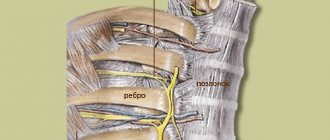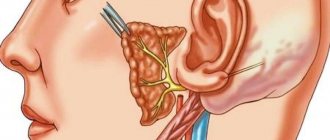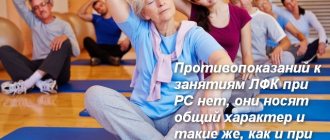Intercostal neuralgia
This is a pain syndrome caused by damage to the peripheral nerves of the chest. Appears due to inflammation, irritation or pinching of the nerve roots in the intercostal space. Intercostal neuralgia is not a disease - it is a syndrome that can appear against the background of various pathologies. Vertebrogenic thoracalgia (as intercostal neuralgia is called) is a general concept that refers to pain that occurs in the chest area. They can appear for no particular reason, or can serve as a sign of various diseases.
Symptoms may resemble pain from a heart attack, pneumonia or pleurisy, diseases such as pancreatitis and others. A characteristic symptom is an increase in pain when coughing, laughing, moving, bending the body and decreasing at rest and with muscle relaxation. This is a distinctive feature of intercostal neuralgia, which allows it to be differentiated from symptoms of heart disease or other pathologies. But you shouldn’t take risks and try to diagnose yourself. The cost of a mistake can be higher than the prolonged pain syndrome.
The principles of treatment and symptoms of intercostal neuralgia in men and women are similar. The main manifestation is pain:
- Paroxysmal, occurring on its own.
- Monotonous, aching.
- Intensified by movement, deep breathing and exhalation, laughter, coughing.
- Occurs when pressing on individual points on the front of the chest or side.
- A burning sensation in the area where the nerve is damaged.
- Numbness, “pins and needles” sensation.
The pathology is more common on the left side of the body, and in women, intercostal neuralgia is a fairly common companion to pregnancy. During this period, the growing fetus puts pressure on the organs in the abdominal cavity, which can lead to pinched nerves.
Set of exercises
The following exercises must be performed:
- Take a few deep breaths in and out. This will increase blood flow and help warm up the muscles.
- Slight tilts from side to side. Place your feet shoulder-width apart, and relax your arms at the beginning of the exercise. Gradually increase the amplitude of the tilt and alternately stretch your arms up behind your head. Repeat 15–20 times.
- In a standing position, place your hands on your belt and perform 8-12 turns of the body to the right and left.
- Bend forward. Place your feet shoulder-width apart, body straight, arms extended down. Take a deep breath and, as you exhale, gently lower your head, round your back and, relaxing, bend towards your feet. Remain in this position for a few seconds and carefully return to the starting position. When lifting up, raise your arms above your head and bend back a little. Perform 5–7 times.
- While lying down on a parallel bench or sofa, hang your head over the edge and stretch your arms with weights (water bottle, dumbbells) forward. Slowly move your arms back behind your head with maximum amplitude while taking a deep breath. As you exhale, return to the starting position, lifting your shoulder blades off the surface. The number of repetitions is 10 times.
- "Kitty." Get on your knees and lean on your hands (take the position “on all fours”). Slowly bend and round your back. Perform the exercise for 2–3 minutes.
- "Cobra". From the starting position of the previous exercise, stretch your arms forward and place your knees, stomach and thighs on the floor. Stretch your head and shoulder blades back a little and lie on the floor. Then slowly raise your shoulders, straighten your arms and return to the lying position. Repeat the exercise 10–12 times.
- “Boat” according to Bubnovsky’s method. Lying on your stomach, extend your arms along your body, keep your legs together. Lift your shoulders, arms and legs off the floor and slowly return to the starting position. Perform the exercise for 1–2 minutes.
- While lying on the floor, place your feet on the floor, stretch your arms forward and place your chin on the floor. Smoothly round your back and stretch it up, then slowly return to the starting position. Perform 10 repetitions. Exercise according to the Dikul method.
- Squats. Place your feet slightly wider than your shoulders, keep your body straight, hands on your belt. Slowly perform a shallow squat and smoothly level up, keeping your body as straight as possible. The number of repetitions is 10–12 times.
Causes
Intercostal neuralgia can be caused by various reasons. Basic:
- Poor posture, injuries, intervertebral hernias, osteochondrosis.
- Hypothermia, which led to poor circulation.
- Infectious and other diseases that lead to nerve damage. For example, destruction of the nerve sheath in multiple sclerosis.
- Neoplasms that compress nerve roots.
- Muscle spasms, prolonged tension during sudden movements or prolonged uncomfortable body posture.
- Operations.
- Pathologies of internal organs.
Set of exercises
- The patient lies on a special mat for gymnastics. Shoes and socks should be removed. You need to stretch your upper limbs up, feet down. Then pull your toes towards you, your feet pointing upward. The body can wriggle, with this exercise against intercostal neuralgia stretching the spinal column.
- Next, the patient lies with arms outstretched, shoulder girdle lowered, each foot pressed to the floor. You need to move your pelvis to the left side. Inhale, while exhaling, each knee goes to the right side, rushing together to the surface of the floor. At this moment the head looks in the other direction. This state must be fixed for 15 seconds, and also performed on the other side.
- Continue to lie on the surface of the floor, the upper limbs should be lowered so that they are parallel to the body, the soles are connected, each knee is spread to different edges. While inhaling, raise the sacrum with the lower back and chest. Move the cervical spine to relieve tension. Fix this state for up to 10 seconds, return the body to a horizontal position in the reverse order of execution. Do 4 approaches. The gluteal area should be tense and the neck should be relaxed.
- Connect the lower limbs and pull them towards the chest. Hug your knees with your palms. Inhale, as you exhale, your forehead should touch your knees. After 2-3 seconds, lower yourself to the floor surface.
Perform the exercises slowly and concentrate on your sensations. If you experience the slightest discomfort, reduce the intensity and increase the amount of rest.
- Stretch your lower limbs, slightly bending them at the knee joints, pull them to your chest, and hug the popliteal area of both legs with your upper limbs. Roll on your back with caution. Repeat the exercise no more than 3 times. You should not overstrain your neck, it is unsafe.
- Sit in the lotus position if possible. Take the upper limbs behind the back area, each hand parallel to each other. The chest is sagging anteriorly. Raise the pelvic area while inhaling, the gluteal muscles are tense. Then slowly lower down. Perform no more than 4 times. Make sure that the cervical spine is not overstrained.
- Next you need to sit down. The lower back is straightened, the lower limbs are brought together, the knee joints are bent, each heel is pulled towards the gluteal area. Use your palms to fix the popliteal area. Having rounded your back, you need to lower yourself down, inhaling at the same time. As you exhale, pull your body back toward your lower limbs. Repeat the exercise 3 times.
- Spread the lower limbs at shoulder width, bend the knee joints, and move the upper limbs behind the back so that they lie under the shoulder girdle. Raise the pelvic area. The body with the head and hips form a straight line. Perform the exercise 4-5 times.
- While sitting, extend your lower limbs forward. Upper ones ─ lift up, secure in a “lock”. The back stretches upward. Each leg is completely relaxed.
- Stretch both arms forward. As you exhale, turn your entire body to the left side with the left upper limb abducted 180°. Also perform this exercise in the opposite direction. It will stretch the intercostal spaces well, and intercostal neuralgia will gradually disappear.
- The left leg must be bent at the knee joint. The right palm is located on the left knee joint, and the left palm is located on the floor surface from the side edge. Perform several smooth twists to the left side. The coccygeal area and the crown form a straight line. The thoracic spine is pulled towards the left edge and upward. This exercise is also useful for eliminating neuralgia and will stretch the chest well.
- Sit cross-legged with your arms down in front of you, resting on your palms. Lower yourself forward, relaxing your lumbar region as much as possible.
- Stand up. Soles ─ shoulder width apart. Raise your upper limbs above your head, clasping your fingers. Turn your torso towards the left edge. Hold the position for 2-3 seconds, repeat on the opposite side.
- Repeat the previous type of exercise with the upper limbs already placed on the sides.
- Spread your arms to the sides, touch one to the floor surface, and raise the other up. Position your head so as to look at the raised upper limb.
- Two hands should touch the floor, each leg straight. Stretch your back, gently bend down, fix the position for no more than 10 seconds.
This treatment at home can be performed daily to eliminate intercostal neuralgia. You just need to not be lazy and do these exercises.
Diagnostics
Intercostal neuralgia can be a symptom of many diseases - from cardiovascular pathologies to diseases of the internal organs of the abdominal cavity and chest. It is impossible to independently determine the cause only from existing complaints. A consultation with a neurologist and a comprehensive diagnosis is necessary to ensure that there are no diseases of the heart, lungs, or digestive system.
Particular attention is paid when diagnosing and treating intercostal neuralgia on the left side. Acute pain in the heart may be a sign of a heart attack. Symptoms usually differ - for example, with heart problems, cold sweat appears and shortness of breath bothers you, the pain does not decrease with rest when the muscles relax. But making a diagnosis based only on symptoms is wrong. The doctor is responsible for the life and health of the patient, which means he needs confidence in the diagnosis and correctness of treatment.
The procedure for examining a patient with suspected intercostal neuralgia is as follows:
- Questioning the patient about complaints and the characteristics of their occurrence.
- Examination to find the location of the pain.
- Setting up a preliminary diagnosis.
- Carrying out examinations to confirm intercostal neuralgia, its causes and prescribe the treatment that will be required in a particular case.
The following diagnostic methods can be used:
- Magnetic resonance imaging or computed tomography is a study that will provide detailed and highly accurate images of tissues and pathology in them.
- ECG – monitoring of heart function to exclude cardiovascular diseases.
- Ultrasound of the heart or other internal organs, diseases in which may have similar symptoms.
- X-ray of the lungs to exclude pneumonia, pleurisy and other diseases in which there are complaints of chest pain.
Diagnostic methods are selected individually depending on the nature of the pain and its location, and the patient’s condition. In some cases, other specialists are involved in diagnosis and treatment - a cardiologist, gastroenterologist, pulmonologist.
The human nervous system is very well developed. When “trouble” happens to her, it makes itself felt, causing certain symptoms. A fairly common pain syndrome is intercostal neuralgia . The word neuralgia itself combines two concepts. "Nevron" meaning "nerve" and "algos" meaning "pain". Accordingly, the disease is pain in the nerves located between the ribs (intercostal nerves).
SYMPTOMS OF INTERCOSTAL NEURALGIA
There are certain symptoms that make it possible to “recognize” this disease. How to recognize it, after all?
The most important symptom indicating the presence of intercostal neuralgia is pain localized between the ribs - in the intercostal spaces. The area of the chest from the fifth to the ninth ribs is most often affected. The pain itself is quite varied, it either appears in attacks, or constantly bothers the person, while preventing him from making the usual movements of the upper half of the body. Many patients even get used to it, so they often remember its existence only during an exacerbation.
What triggers an attack of pain?
It can occur with any movements that promote stretching of these same intercostal spaces. Very often, pain can occur (or intensify) during a deep breath, or when a person tries to talk loudly. Coughing and sneezing are also accompanied by chest pain. If you press on the area between the ribs, it is painful. Sometimes patients feel as if their chest is burning or “stabbing,” and some, touching the “sore” area, simply do not feel anything, because numbness along the intercostal nerves is also a sign of their damage.
Patients can take an antalgic position, one in which pain decreases or disappears. In this case, the patient can tilt the upper body in the direction opposite to where the pain is localized.
The intercostal nerves are highly branched, their branches are directed in different directions, so the pain with intercostal neuralgia may resemble pain with other diseases.
Considering the possible sharp nature of the onset of an attack of pain, it can imitate an attack, for example, with angina pectoris. The patient can independently determine whether the heart or nerve endings hurt.
If this is angina pectoris, then the pain is necessarily localized behind the sternum, it presses, pulsates, in addition, there are disturbances in the pulse, pressure, and when the posture changes, the pain does not change its character.
If it is intercostal neuralgia
, then the pressure and pulse are normal, but the nature of the pain changes with the slightest stretching of the intercostal spaces. The branches of the intercostal nerves even reach the lower back, so you can often confuse an attack of neuralgia with an attack of colic in the kidneys. If a patient experiences pain in the area of the shoulder blades, along the spine or in the shoulder, as if being injected or cut with a knife, this may also indicate intercostal neuralgia. In addition, if the pain intensifies when the muscles of these areas are stretched, then this once again confirms the diagnosis.
CAUSES OF INTERCOSTAL NEURALGIA
Painful sensations can arise due to a certain reflex on the part of the intercostal nerves, provoked by the action of exogenous (formed outside the body) and endogenous (formed in the human body) factors. Under the influence of provoking factors, the nerves are irritated, which causes pain. Depending on how strong the irritating factor is, the pain will be so intense.
Progressive thoracic osteochondrosis is the most common cause of the development of the disease, since in this case the following is observed:
- spinal instability - displacement of the vertebrae, which causes pinching of the spinal nerve roots and disrupts their proper functioning,
- Protrusions or herniated discs form between the vertebrae, and they can cause compression (pressure), i.e. irritate the intercostal nerves, namely their roots, damaging them, which causes pain at the site of pinching (irritation) and along the course of the nerve.
Herpes zoster (popularly known as shingles) is also a fairly common cause.
Intercostal neuralgia
may be a consequence of a certain disease of the spine, and under the influence of certain irritating factors it externally manifests itself as pain along the intercostal nerves. Such diseases include spondylitis, spondyloarthritis, ankylosing spondylitis, and various neoplasms (benign or malignant tumors) localized in the spine can also irritate the nerves.
In principle, any type of factor can cause an attack of pain: physical, chemical, biological. As mentioned earlier, when performing sudden or unusual physical exercises without specific preparation, the muscles in the intercostal spaces suddenly stretch, which leads to irritation of the nerve endings. In addition, normal hypothermia, or the flu or the herpes virus (which causes shingles) can also irritate the nerve endings. Irritating factors also include intoxication of any origin (viral, alcohol, intoxication with paints and paints, etc.), excessive emotional excitability or chest injury. But symptoms indicating neuralgia of the intercostal nerves can not only be a consequence of the direct action of the irritant on these nerve endings, they can also reflect pathological processes in nearby organs and tissues.
Thus, intercostal neuralgia can “copy” the clinical picture of an inflammatory disease of the pleura (pleurisy), narrowing of the part of the aorta located in the thoracic region, mediastinal neoplasms (benign or malignant), any inflammatory or deforming processes of the spine, and so on.
Therefore, given the fact that a huge number of diseases of both the musculoskeletal system and other systems, individual organs and tissues of a person can cause symptoms similar to intercostal neuralgia, it is not worthwhile to independently determine what kind of disease it is, much less try to treat it, since how, while curing, as you believe, the true cause of the disease, you can miss or aggravate another - the main cause, which can lead to unpleasant and dangerous consequences that will have to be dealt with for a long time. Therefore, if you discover the first signs of damage to nerve endings, immediately consult a doctor.
PREVENTION OF INTERCOSTAL NEURALGIA
General prevention methods are quite simple and are aimed at preventing irritation of the intercostal nerves. You need to regularly do morning exercises, it is advisable to visit the pool, try to limit yourself in physical activities, especially heavy ones, dress warmly, avoid drafts, so as not to get too cold and catch a cold. And, of course, if there is an underlying disease (from viral infection to the final stage of osteochondrosis), treat it.
DIAGNOSIS OF INTERCOSTAL NEURALGIA
First of all, you can do the diagnosis yourself, which will only allow you to suspect the disease, after which you should immediately consult a doctor.
How is this done?
Firstly, it is worth trying to determine exactly what kind of pain this is, where it is located and why, in fact, it arose. The pain may persist for a long time, or may disappear, manifesting itself in attacks. You can palpate (feel) the ribs, and most importantly, the spaces between them. If this is a lesion of the intercostal nerves, then it is the intercostal spaces, and not the ribs themselves, that will hurt. You can try bending your upper body in different directions, spinning around, trying to cough or even scream. All this leads to stretching of the muscles located between the ribs and irritation of the endings. If the symptoms are similar to the disease you are looking for, you should try to remember or associate this pathology with any previous disease. For example, does the patient have musculoskeletal diseases, has he recently had a cold, has he been hypothermic, has he suddenly gone to the gym after a long break, or were there any factors contributing to the development of intoxication (drinking alcohol, inhaling varnishes or paints, etc.).
Next, the doctor will conduct the examination. First of all, he conducts a detailed questioning of the patient. The doctor asks about the nature of the pain (cutting, burning, dull, pressing, aching pain, etc.), about its location (at a certain point or throughout the chest), whether the pain radiates to the shoulder blade, lower back, perhaps to other parts bodies. It is also important to find out the cause of its occurrence. In addition to the fact that the patient himself will tell you about all his previous diseases, the doctor asks to bring the results of examinations (if available): x-rays, results of ultrasound examination (ultrasound), computed tomography (CT), magnetic resonance imaging (MRI). All this will help in identifying the cause of the pain. It is also important to ask the patient whether the patient had relatives with similar symptoms or, at least, with diseases of the musculoskeletal system, since many of them are inherited.
After a detailed questioning, the doctor independently examines and examines the patient: palpates painful areas, conducts a detailed examination of the musculoskeletal system and nervous system, while studying muscle tone and the presence or absence of sensitivity in certain parts of the body.
If necessary, the doctor can send the patient for tests or instrumental examination methods, depending on the suspected pathology.
Treatment
The goals of therapy for intercostal neuralgia: reduce pain, eliminate the cause of pinching or inflammation.
For this purpose, drug treatment is prescribed using:
- Muscle relaxants to relieve muscle spasms.
- Neuroprotectors for the protection and restoration of nerve cells.
- Painkillers and injection therapeutic blockade with various drugs. It has a strong analgesic effect, relieves swelling and eliminates muscle spasms.
Drug treatment of intercostal neuralgia is complemented by physiotherapy. The following physiotherapeutic procedures can be used:
- Exercise therapy is an individually selected set of exercises to relax spastic muscles, improve blood circulation and lymph flow in the problem area. Exercise therapy is effective for the treatment and prevention of neuralgia, but it can only be done if there are no contraindications. It is important not to cause harm, which is possible with home exercises. What exercises will be effective, how exactly to do them, the number of repetitions - all this will be advised by a physical therapy doctor. The safest and most effective classes are under the supervision of a physical therapy instructor in individual or group classes.
- Laser therapy uses light energy to increase blood circulation, relax muscles, and reduce pain and inflammation.
- Magnetotherapy - the effect of an electromagnetic field on the body leads to the elimination of congestion, improvement of blood circulation, and reduction of pain syndromes.
- Diadynamic therapy, galvanization, exposure to interference currents and other procedures with electric current of varying power and frequency. They have a healing effect on soft tissues, improving blood circulation and lymph outflow, relaxing muscles and providing an analgesic effect.
- Electrophoresis is a procedure that improves the penetration of drugs into soft tissues and accelerates their action.
- Therapeutic massage and manual therapy are methods of influencing the body with the hands of a doctor. They allow not only to reduce or completely relieve pain, but also to treat the causes of intercostal neuralgia - pathologies of the spine, functional blocks in its work. What exactly to use - acupressure, segmental or other types of massage - is decided by a chiropractor or massage therapist.
- Acupuncture (acupuncture) – injections with thin needles into biologically active points on the body to relieve pain and normalize the functioning of internal organs.
Treatment of intercostal neuralgia on the right or left side of the chest, in the side with the help of physiotherapeutic procedures is carried out in several procedures. A full course usually consists of 10-15 sessions. Appointments are always individual.
Exercises with auxiliary objects
Exercise therapy for intercostal neuralgia can be performed using auxiliary objects. The most effective exercises:
- For this exercise you will need a fitball and a rubber band folded in two. A fitball is a large elastic ball from 45 to 95 cm in diameter. You need to sit on the ball, then one end of the rubber band is thrown onto the right foot, and the left one remains to the side. The other end of the tourniquet must be held firmly in your right hand. The elbow of the left hand rests on the left knee, then, as you exhale, the right arm straightens diagonally. Gradually the number of repetitions can be increased to 15.
- Sitting on a fitball, you need to bend back, clasping your hands behind your head, then smoothly turn your body left and right.
- You will need a roller made from a towel. A towel folded in four is placed between the shoulder blades or under the lower back, depending on the location of the pain. The legs should be placed on the fitball, and the arms should be moved so that the hands are near the ears. In this case, the shoulder blades need to be raised about 10 times.
Exercise therapy not only allows you to treat pinched intercostal nerves at home, but is also an effective prevention of this condition. It is important to follow all the rules and precautions, you need to increase the load gradually and not skip health-improving workouts, then gymnastics will be beneficial and will become an effective addition to drug and physiotherapeutic treatment.
Prevention
The following recommendations help to avoid the appearance of intercostal neuralgia:
- Moderate physical activity to strengthen the muscle frame and maintain their elasticity.
- Maintaining correct posture.
- Healthy eating.
- Daily routine and alternation of work and rest time.
- Protection against hypothermia.
You should not endure the pain of intercostal neuralgia and worry about its causes - consult a doctor to be sure that there are no serious pathologies and for quick relief of symptoms.
Technique and implementation features
Before you start training, read the basic rules of training:
- Gymnastic elements should be selected by a physical therapy doctor individually, taking into account the severity of changes and initial physical fitness;
- You can start the main workout only after a five-minute warm-up: stretch, walk in place, rotate your head and arms;
- Increase the loads gradually, starting with a minimum number of approaches;
- All movements must be carried out at a smooth, slow pace;
- If pain occurs all the time when performing a certain task, then it is better to abandon it;
- Exercise regularly, daily. Spontaneous physical activity can only disrupt all compensatory mechanisms. The body must be ready for exercise;
- Arrange short physical exercise sessions at work, they will prevent a relapse of intercostal neuralgia.
Exercise therapy for neuralgic pain helps not only to get rid of it faster, but also to avoid pathology in the future. On the one hand, gymnastics makes it possible to find a balance between contracting some muscles and relaxing their antagonists, on the other hand, it directly affects bone structures, forming correct posture and ensuring flexibility of the spine. To choose the right complex, you must first consult a specialist.
